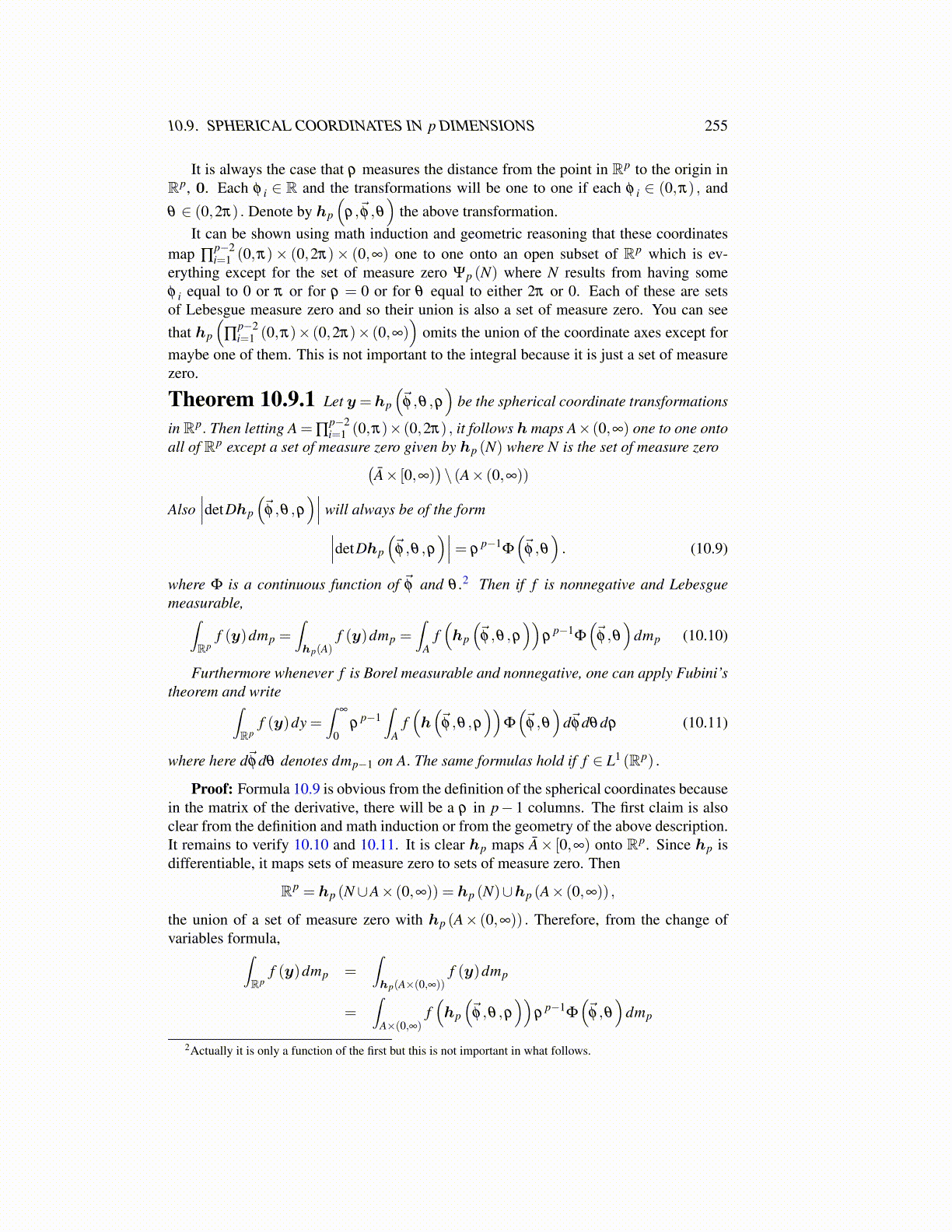
10.9. SPHERICAL COORDINATES IN p DIMENSIONS 255
It is always the case that ρ measures the distance from the point in Rp to the origin inRp, 0. Each φ i ∈ R and the transformations will be one to one if each φ i ∈ (0,π) , and
θ ∈ (0,2π) . Denote by hp
(ρ, φ⃗ ,θ
)the above transformation.
It can be shown using math induction and geometric reasoning that these coordinatesmap ∏
p−2i=1 (0,π)× (0,2π)× (0,∞) one to one onto an open subset of Rp which is ev-
erything except for the set of measure zero Ψp (N) where N results from having someφ i equal to 0 or π or for ρ = 0 or for θ equal to either 2π or 0. Each of these are setsof Lebesgue measure zero and so their union is also a set of measure zero. You can seethat hp
(∏
p−2i=1 (0,π)× (0,2π)× (0,∞)
)omits the union of the coordinate axes except for
maybe one of them. This is not important to the integral because it is just a set of measurezero.
Theorem 10.9.1 Let y =hp
(⃗φ ,θ ,ρ
)be the spherical coordinate transformations
in Rp. Then letting A = ∏p−2i=1 (0,π)× (0,2π) , it follows h maps A× (0,∞) one to one onto
all of Rp except a set of measure zero given by hp (N) where N is the set of measure zero(Ā× [0,∞)
)\ (A× (0,∞))
Also∣∣∣detDhp
(⃗φ ,θ ,ρ
)∣∣∣ will always be of the form∣∣∣detDhp
(⃗φ ,θ ,ρ
)∣∣∣= ρp−1
Φ
(⃗φ ,θ
). (10.9)
where Φ is a continuous function of φ⃗ and θ .2 Then if f is nonnegative and Lebesguemeasurable,∫
Rpf (y)dmp =
∫hp(A)
f (y)dmp =∫
Af(hp
(⃗φ ,θ ,ρ
))ρ
p−1Φ
(⃗φ ,θ
)dmp (10.10)
Furthermore whenever f is Borel measurable and nonnegative, one can apply Fubini’stheorem and write∫
Rpf (y)dy =
∫∞
0ρ
p−1∫
Af(h(⃗
φ ,θ ,ρ))
Φ
(⃗φ ,θ
)dφ⃗dθdρ (10.11)
where here dφ⃗dθ denotes dmp−1 on A. The same formulas hold if f ∈ L1 (Rp) .
Proof: Formula 10.9 is obvious from the definition of the spherical coordinates becausein the matrix of the derivative, there will be a ρ in p− 1 columns. The first claim is alsoclear from the definition and math induction or from the geometry of the above description.It remains to verify 10.10 and 10.11. It is clear hp maps Ā× [0,∞) onto Rp. Since hp isdifferentiable, it maps sets of measure zero to sets of measure zero. Then
Rp = hp (N∪A× (0,∞)) = hp (N)∪hp (A× (0,∞)) ,
the union of a set of measure zero with hp (A× (0,∞)) . Therefore, from the change ofvariables formula,∫
Rpf (y)dmp =
∫hp(A×(0,∞))
f (y)dmp
=∫
A×(0,∞)f(hp
(⃗φ ,θ ,ρ
))ρ
p−1Φ
(⃗φ ,θ
)dmp
2Actually it is only a function of the first but this is not important in what follows.